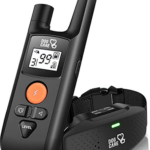
When shopping for a dog care training collar, look for one with adjustable features and multiple adjustment settings to meet the needs of different breeds and sizes of pets. Tone and vibration options give you flexibility in selecting an effective training method for your furry friend. In addition, make sure it is made from quality materials designed for safe use.
If safety is of primary importance to you, look for a training collar equipped with a safety lock button on its remote control. This feature prevents accidental clicks that might activate correction mode and safeguard both you and your pup’s wellbeing as you train effectively together.
An important consideration when purchasing a dog training collar is its number of channels supported. Make sure that it’s enough to support all your dogs so you can manage all of them at the same time, while still following commands reliably.
The DOG CARE training collar is an incredibly useful and versatile device, ideal for both indoor and outdoor training of dogs. Boasting a range of up to 1000 feet, you can train your pup from any part of the yard or neighborhood. Furthermore, its features make it safer than traditional shock collars; including its “blunt stimulation” option which offers tapping sensation rather than static shocks.
This collar is both comfortable and durable, featuring a soft nylon strap that fits securely around your dog’s neck. Perfect for all weather conditions–rain or snow–its IP67 waterproof receiver allows your pup to dip his nose in, although we advise taking precautions against submersion during swimming or bath time. Plus, with its security keypad lock feature on its remote remote you’ll avoid accidental button presses that may send unwanted instructions out at inconvenient moments!
Your dog may take time to adjust to his or her training collar. You should gradually introduce it over a few days by first petting and praising him/her while wearing it, then touching various places of the collar with gentle touches, such as gently patting his/her neck. If they do not respond, use more subtle pressure.
Once your dog is familiar with his or her training collar, you can gradually introduce more complex situations into his or her routine. When correcting your dog in public settings, vibration and beep modes should do just fine in getting their attention, while shock mode should provide even more forceful correction if necessary.








